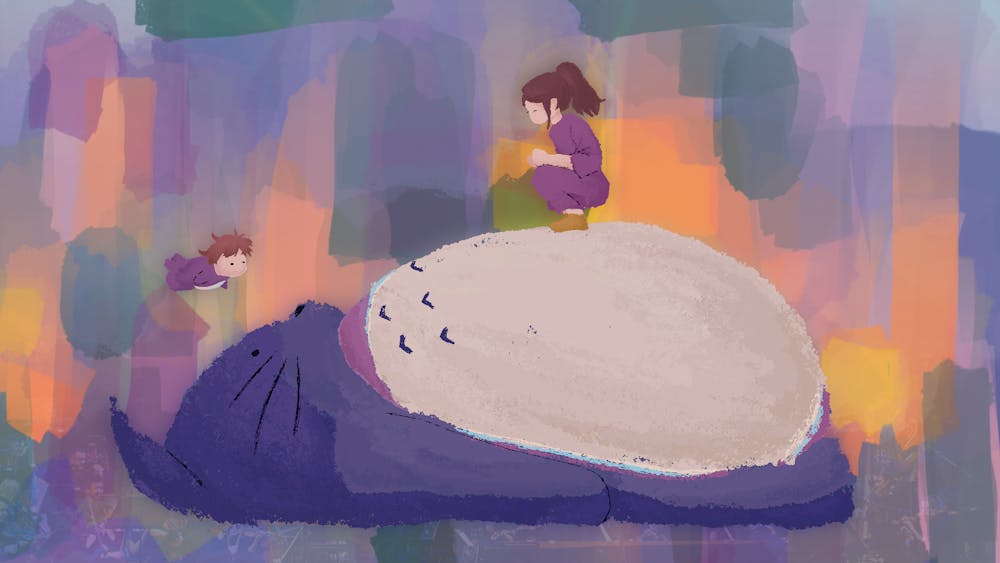In a Miyazaki film, time is granted to allow the characters to live.
Characters interact with their world, and pushing the storyline is a byproduct. In Ponyo, time is given to Ponyo fumbling through a task as simple as making instant ramen. Despite there being no narrative reason to do so, Satsuki in My Neighbor Totoro is shown carefully preparing lunch for her father and younger sister Mei. No action is considered a waste of time. A breath exhaled, hair tucked behind the ear, fidgeting hands all add to the humanity of each character, ensuring their world is rich with life.
This principle that guides Miyazaki’s films is called Ma. In an interview with Roger Ebert from 2002, Miyazaki famously clapped several times. He then explains, "The time in between my clapping is Ma. If you just have nonstop action with no breathing space at all, it's just busyness, but if you take a moment, then the tension building in the film can grow into a wider dimension. If you just have constant tension at 80 degrees all the time, you just get numb."
While blockbuster action films are easily profitable and seemingly easy to make, they also fall flat pretty easily. Booming scores and nonstop fight scenes become standard. There is no climactic point for audiences to anticipate, no emotional release to await. By constantly filling silence, once–impactful twists and turns dull in comparison.
In Spirited Away, a film famous for its iconic soundtrack, the most iconic scene occurs with nearly no sound. For three minutes, we are invited to reflect alongside Chihiro. On a train from the bathhouse to rescue her friend Haku, Chihiro sits in silence. We also sit in silence. We take in her surroundings, reflect on her growth and steel ourselves together to complete the mission. As the silence ebbs and the score eventually swells, Chihiro and Haku reunite, and our eyes well with indescribable overflowing pride.
Chihiro’s triumph accompanied by the score is made all the more impactful because of the preceding silence. Rather than filling his films to the brim with music and dialogue, Miyazaki gives time to let silence bloom. And also because of the silence, the soundtracks and scenes they accompany become all the more poignant and memorable.
Not only is the placement of the scores guided by Ma, Ma is evidenced in the soundtracks themselves. Not every track builds up to a full orchestra. Pieces have lilting piano lullabies; rests are fully realized in between notes. One Summer’s Day from Spirited Away is played at the beginning of the film when Chihiro is in her family’s car on their way to their new home. The piece takes its time to get started: several long whole note chords are played first before the melody begins. It gives us time to get immersed into the film. Each chord is pleasant, but doesn’t quite resolve in a satisfying way. It keeps us interested to discover more about the direction that the piece, and by extension, the movie is heading towards.
This immersion in all levels of a Miyazaki film leaves the audience emotionally attached to all aspects of the film. Just like how we relate to the actions of characters anxiously fiddling their hands and breathing out in peace, Miyazaki’s music also fits neatly into our daily lives, accompanying us as we walk to school, wait for our doctor’s appointments, and eat lunch before our next class. Not all moments of life culminate to a climactic crescendo. The music that best suits our life is one that makes even the most simple of actions all the more special.
We develop an emotional attachment to these pieces because of their comforting familiarity in all moments of life, not just the most action–packed. Even though these pieces eventually become familiar and are played repeatedly, our emotional attachment ensures we don’t get tired of them.
Through pausing the music to give his characters time to exhale, Miyazaki ensures we recognize how his stories can still resonate in a world not filled with loving creatures and magic. And accordingly, our experience during the film and after the film reframes the soundtrack to become music to life itself.







